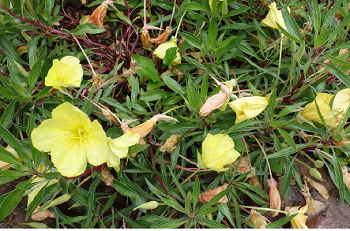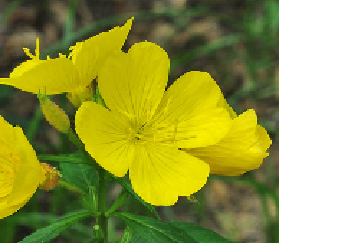
Oenothera sp.
There are 145 species of evening-primrose. Some do indeed, as their name suggests, open at night to the delight of the moths that pollinate them. Others bloom during the daytime. Some are biennial, some are annual, some are perennial and some cross the lines. Pat brought us a video of one of the evening opening varieties at the last meeting. It opens quickly enough so that it is possible to see the flower unfolding. We were going to post it on our Facebook page but the file was too large to email from Pat’s phone. .
The wild evening primrose is Oenothera biennis. This is almost certainly not he one Pat has. We base this probability on the observation of the wild variety on the embankment where it is a horrible invasive weed. The flowers are small on biennis and while it might be grown for its medicinal properties no one is going to grow it for its beauty. It also reaches a height of 5-6 feet.
Pat’s plant may be Missouri primrose or Oenothera macrocarpa . It is a much smaller plant than the 6 feet that the native biennis can reach topping out at 12 inches. The Oenothera macrocarpa flowers are bright yellow and may be as large as 5 inches in diameter. There are a number of cultivars and this seems to be the yellow one that is most commercially viable.
These plants are biennials. The plant produces vegetative growth the first year, overwinters and flowers the second year. It sets seed and those seeds are the new crop of plants for the next year. The seeds have to be stratified to germinate so the easiest way to obtain new plants is to simply scatter the seeds in the fall. This is the easiest way but perhaps not the surest way as the seeds may germinate irregular. After a few years the plants can disappear completely. This is what happened to the ones I had growing although a plant will still pop up occasionally. It is to be noted that the seeds are also light dependent for germination so they should not be planted too deeply. While the plnats are small they should be kept weed free as the seedlings are not very competitive.
The surest way to keep the plant growing is to collect the seeds in the fall and plant them in covered containers. Put these containers outside through the winter and the seeds will germinate in the spring. When they are growing well they can be moved to the desired location. Like many plants they will reseed in the garden only if they are happy with the location.
The evening primrose thrives in bright sun. It is one of those plants that will grow in rocky soil that is dry and not particularly fertile. It survives drought conditions and is often found growing in disturbed soil. If it does seem to die out turning over the soil may encourage germination.
Currently, we have a day-flowering evening primrose as well as the night blooming one. It came, I think, with a batch of plants from Ralph. It wasn’t labeled so it go planted in the ground in the hopes that it would be identified when it bloomed. It did bloom this year and we believe it is O. fruticose. These day blooming evening primroses are known as sundrops.  They reach a height of about 15 to 24 inches. The flowers are similar to the evening blooming one. The flowers do not last long but it does bloom over almost a 2 month period. Again, the plant will grow in poor soil with good drainage but it does better when organic material is added to the soil. They grow best in full sun and will tolerate extreme heat as well as some drought.. The day blooming evening primrose is supposed to produce red leaves in the fall adding a touch of color to the autumn garden.
They reach a height of about 15 to 24 inches. The flowers are similar to the evening blooming one. The flowers do not last long but it does bloom over almost a 2 month period. Again, the plant will grow in poor soil with good drainage but it does better when organic material is added to the soil. They grow best in full sun and will tolerate extreme heat as well as some drought.. The day blooming evening primrose is supposed to produce red leaves in the fall adding a touch of color to the autumn garden.
Again, this plant is a biennial. If it is possible to acquire a non blooming plant it may be transplanted and it will appear next year. The blooming plants are probably not going to come back. The tricky thing with biennials is that they may actually reappear for more than one season and this is one of those plants. Many sources list it as a perennial but unfortunately that is a quirk of the individual plant. Don’t count on seeing it next year and do collect some seed.
The really interesting thing about the evening primrose is its myriad uses, most of them medicinal. While the properties are inherent in all members if the family they are probably most concentrated in the wild evening primroses, O. biennis, The plant is native to North America and Canada and the native tribes used it for both food and medicine. Almost the entire plant is edible. The leaves can be used in salads, as can the flowers, or the leaves can be cooked in the manner of spinach or kale. The roots and seed pods can be roasted and even the stems can be incorporated into various dishes.
Where the primrose really shines is its use in medicines. Traditionally, the leaves and roots of the plant have been used in teas or poultices to treat bruises, as a stimulant, for coughs and for upset stomachs. Currently, the oil is expressed commercially from the seeds. The effective component is Gamma-Linolenic Acid (GLA), an omega-6 fatty acid. It is essential for good health. Medicinally primrose oil is frequently used to treat acne, to protect against nerve damage in diabetics, for painful breasts and a myriad of other complaints. Scientific data isn’t available for most uses and where it is it is often conflicting. It is also used in cosmetics. You can make your own evening primrose oil. From the leaves of the plant although it probably won’t have the strength of the commercial oil. It can be used for skin care of as a salad oil. The simple method follows:
Sterilize a glass jar
Fill it loosely with either flowers or leaves of the evening primrose. Make sure they are dry.
Cover with with oil. Vegetable or olive oil for salads. Other oils may be used for cosmetic purposes.
Remove air bubble by stirring.
Let sit for 2 weeks shaking daily.
Strain out the vegetable matter and seal.
To preserve freshness refrigerate